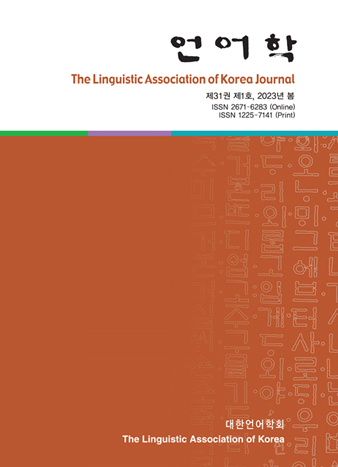대한언어학회 전자저널

31권 1호 (2023년 3월)
- From Gender-Biased to Gender-Specific and Gender-Inclusive Words: A Corpus-Based Study
-
Cuilin Liu · Se-Eun Jhang · Sunghwa Lee
Pages : 85-112
Abstract
Liu, Cuilin; Jhang, Se-Eun & Lee, Sunghwa. (2023). From gender-biased to gender-specific and gender-inclusive words: A corpus-based study. The Linguistic Association of Korea Journal, 31(1), 85-112. The purpose of the present study is to gain insight into the trends in using SEAMAN and SEAFARER in maritime English and general English while tracking changing features in using gendered and gender-inclusive personal nouns in maritime English in order to investigate the popular gender-specific words used in contemporary English. We diachronically examine the frequency of some pre-determined terms such as seafarer, he, or she as well as the context by relying on the corpus-based approach. Gender-inclusive words like seafarer/s and he or she have been used in maritime English. In contrast, male-biased SEAMAN is still more frequently used than SEAFARER. Gender-specific words that refer to women began to appear in the 2000s in maritime English, and various forms like seawomen/female seafarers have appeared in contemporary English with compounds more popularly. Comparatively, gender-biased occupational nouns seem to gain more attention than gendered pronouns, which makes gender-inclusive occupational nouns adopted earlier than pronouns.
Keywords
# maritime English # gender-biased # gender-inclusive # diachronic # ESP # corpus-based approach
References
- Baker, P. (2010). Will Ms ever be as frequent as Mr? A corpus-based comparison of gendered terms across four diachronic corpora of British English. Gender and Language, 4(1), 125-149.
- Benatar, D. (2005). Sexist language: Alternatives to the alternatives. Public Affairs Quarterly, 19(1), 1-9.
- Biber, D. (1988). Variation across speech and writing. Cambridge: Cambridge University Press.
- Biber, D., Johansson, S., Leech, G., Conrad, S., & Finegan, E. (1999). Longman grammar of spoken and written English. Harlow: Pearson Education Limited.
- BIMCO, & International Chamber of Shipping (2016). Manpower report: The global supply and demand for seafarers in 2015. Maritime International Secretariat Services Limited.
- Caldas-Coulthard, C. R., & Moon, R. (2010). ‘Curvy, hunky, kinky’: Using corpora as tools for critical analysis. Discourse & Society, 21(2), 99–133.
- Curzan, A. (2003). Gender shifts in history of English. Cambridge: Cambridge University Press.
- Davies, M. (2010) The corpus of historical American English (COHA). Available online at https://www.english-corpora.org/coha/.
- Drewry, International Labour Organisation, & International Transport Workers\' Federation (2009). Manning 2009. London: Drewry Maritime Research.
- Hartman, P., & Judd, E. (1975). Sexism and TESOL materials. TESOL Quarterly, 12(4), 383–393.
- Hellinger, M. (2001). English—gender in a global language. In M. Hellinger & H. Bußmann (Eds.), Gender across languages: The linguistic representation of women and men, (Vol. 1, pp. 105–113). Amsterdam, The Netherlands: John Benjamins Publishing Company.
- Holmes, J. (1986). Functions of you know in women’s and men’s speech. Language in Society, 15(1), 1–21.
- Holmes, J. (1993). He-man beings, poetesses, and tramps: Sexist language in New Zealand. In L. Bauer and C. Franzen (Eds.), Of pavlova, poetry and paradigms: Essays in honour of Harry Orsman (pp. 34–49). Victoria: Victoria University Press.
- Holmes, J. (2001). An introduction to sociolinguistics (2nd ed.). London: Longman.
- Holmes, J., & Sigley, R. (2001). What\'s a word like girl doing in a place like this? Occupational labels, sexist usages and corpus research. Language and Computers, 36, 247-263. https://www.researchgate.net/ publication/233615516
- Hong, S. C., & Jhang, S. E. (2010). The compilation of a maritime English corpus for ESP learners. Korean Journal of English Language and Linguistics, 10(4), 963-985.
- ILO (2005). A global alliance against forced labour―Global report on forced labour 2005. https://www.ilo.org/global/publications/books/WCMS_081882/langen/index.htm Accessed on January 3, 2023.
- Kilgarriff, A. (2001). Comparing corpora. International Journal of Corpus Linguistics, 6(1), 97-133.
- Kitada, M. (2013). Code of behaviour at sea: Women seafarers’ shipboard identity management. WMU Journal of Maritime Affairs, 12(2), 213–227.
- Kitada, M. (2021). Women seafarers: An analysis of barriers to their employment. In V. O. Gekara & H. Sampson (Eds.), The world of the seafarer: Qualitative accounts of working in the global shipping industry (Vol. 9, Ser. WMU Studies in Maritime Affairs, pp. 65–76). Cham, Switzerland: Springer.
- Kjellmer, G. (1986). ‘The lesser man’: Observations on the role of women in modern English writings. In J. Arts & W. Meijs (Eds), Corpus linguistics II (pp. 163– 176). Amsterdam: Rodopi.
- Lakoff, R. (1975). Language and woman’s place. Language in Society, 2(1), 45-80.
- Lindquist, H. (2009). Corpus linguistics and the description of English. Edinburgh: Edinburgh University Press.
- McEnery, T., Xiao, R., & Tono, Y. (2006). Corpus-based language studies: An advanced resource book. London/New York: Routledge.
- Milne, P. J. (1989). Women and words: The use of non-sexist, inclusive language in the Academy. Studies in Religion/Sciences Religieuses, 18(1), 25-35.
- Pearce, M. (2008). Investigating the collocational behaviour of MAN and WOMAN in the British National Corpus using Sketch Engine. Corpora, 3(1), 1–29.
- Rayson, P., Leech, G., & Hodges, M. (1997). Social differentiation in the use of English vocabulary: Some analyses of the conversational component of the British National Corpus. International Journal of Corpus Linguistics, 2(1), 133–152.
- Romaine, S. (1999). Communicating gender. Mahwah, NJ: Lawrence Erlbaum Associates.
- Romaine, S. (2000). Language in society: An introduction to sociolinguistics (2nd ed.). Oxford: Oxford University Press.
- Schmid, H.-J. (2003). Do women and men really live in different cultures? Evidence from the BNC. In T. McEnery, P. Rayson, & A. Wilson (Eds.), Corpus linguistics by the Lune: A festschrift for Geoffrey Leech (pp. 185–221). Frankfurt: Peter Lang.
- Sczesny, S., Moser, F., & Wood, W. (2015). Beyond sexist beliefs: How do people decide to use gender-inclusive language? Personality and Social Psychology Bulletin, 41(7), 943–954. Sunderland, J. (1992). Gender in the EFL classroom. ELT Journal, 46(1), 81–91.
- Tognini-Bonelli, E. (2001). Corpus linguistics at work. Amsterdam, The Netherlands: John Benjamins Publishing Company.
- United Nations. (2020). Gender-inclusive language. https://www.un.org/en/gender-inclusive-language/Accessed on January 3, 2023.